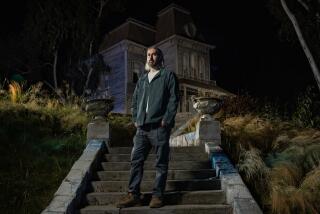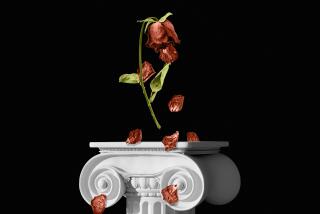Step Right Up: It’s the Strangest Show on Earth
It’s ironic and a bit amusing to see the jaded, Gen-X hipster crowd oohing and aahing over traditional circus sideshow acts like fire eaters, magicians and plate spinners. But that was the scene recently when New York’s Bindlestiff Family Cirkus took over Silver Lake’s Spaceland nightclub for an evening of old-school entertainment with a Fellini-esque twist.
Local magician Christopher Wonder, in stovepipe hat and pancake makeup, opened the show with his rat circus, asking his rodents to tell fortunes before shooting them from a faux cannon. Then ringmistress Philomena Bindlestiff took to the stage. Dressed in a red-and-black tiger-skin leotard, she was accompanied by a gender-bending clown who stuck various pieces of hardware up his nose. Shortly thereafter, a character named Rocket Johnny unsuccessfully tried to ride his pogo stick to the moon, and a red-velvet-suited Mr. Pennygaff swallowed swords.
This ain’t no Ringling Bros. And that’s the point.
“There’s more of an appreciation for a style of entertainment inclusive of many disciplines--the variety show, burlesque and the sideshow circus,” says Stephanie Monseu, 31, a.k.a. Philomena Bindlestiff. “All of these things are very popular right now. TV and computers have isolated people to the point that they want to go back out and become members of an audience.”
For several years, alternative circus troupes like the Bindlestiffs have been putting an irreverent spin on the whole notion of a circus. Jim Rose was first to popularize the form, applying a punk-rock ethos to his Circus Sideshow and accompanying the hugely successful Lollapalooza summer concerts from 1992 to 1996. Rose made a name for himself with acts designed for maximum repulsion.
During roughly the same time period, in 1993, a failed comedian calling himself Chicken John founded Circus Redickuless in Los Angeles, debuting with unusual attractions like the Temporarily Tattooed Man, a life-size version of the board game Mouse Trap and speed-metal tap dancing. His “dysfunctional circus” traveled from town to town in a beat-up van, playing nontraditional venues like trash recycling centers and hoping to make enough money to get them to their next gig.
L.A. native Pascal Franchot, 37, is working on a documentary about the local cabaret-sideshow scene, which, he says, is enormous.
“I don’t think most people are aware of how extensive the underground sideshow culture really is in L.A.,” Franchot says. “I’d say there’s something going on every week, easily.”
He also says most of these events are parties given by performers for performers. Only if you run with the right crowd will you get the invitation. While the alt-circus scene is being taken increasingly aboveground with artists trying to make their mark, it remains amorphous. It is a scene that doesn’t easily jell and that has instead spawned a handful of well-known performance groups which expand and contract to accept local acts as they tour--and a growing number of adherents and die-hard fans.
Franchot, who describes his film, “Cabaret X,” as an updated version of the 1932 movie “Freaks,” believes that Gen-Xers are fueling the current vaudeville renaissance and that the appeal is the same as it was for the grandparents of these 20- and 30-somethings: variety and live performance.
“We’re hungry for the diversity,” he says. “People want to be entertained. If you don’t like one act, then the next one that comes up, hopefully you do.”
For the time being, it would seem that going to see a circus sideshow or a burlesque act is much more hip than attending a ho-hum rock concert. And the cachet of seeing a live, circus-style show easily eclipses movies and TV.
David “the Miracle Man” Markham, 42, has been performing variations on his magic/sword swallowing/strong man act since he was a kid. Markham, born and raised in L.A., says he has noticed a growing interest in his metier.
“There’s kind of a new wave of these things, and a general resurgence in circus and vaudeville with a more youthful crowd,” Markham says. “Partly because they haven’t seen it before. Partly because it’s being presented in a slightly different way. You could present it in the old way, and they’d still be interested. But I think with the new packaging, shall we say, that it’s become more palatable to current audiences.”
Monseu puts the whole movement in historical perspective.
“In the 1890s, the most popular acts were the bizarre, the strange and the unthinkable,” she says. “That was 100 years ago. So if you think about it, there’s really nothing new.”
More to Read
The biggest entertainment stories
Get our big stories about Hollywood, film, television, music, arts, culture and more right in your inbox as soon as they publish.
You may occasionally receive promotional content from the Los Angeles Times.






